A half century ago, the passing of Title IX helped women take their first strides toward leveling the playing field in sports. But today, there are new battlegrounds and issues that will define the future of the fight for equality and dominate conversations for years to come.
EQUAL PAY
When the final whistle blew and sealed the victory for the U.S. women’s national team at the 2019 World Cup, the fans in Lyon, France, erupted in cheers. But one chant in particular reverberated throughout the stadium: Equal pay! Equal pay! Equal pay!
The defining moment was a resounding reminder of soccer’s gender disparities, but it also marked the start of a reckoning in women’s sports that has been 50 years in the making. Since the passing of Title IX, the number of women’s professional leagues has grown exponentially. But as demand increases, salaries have been slow to keep up, and the pay gap is still millions of dollars wide, with the average female athlete making anywhere from 15% to 100% less than her average male counterpart, according to an Adelphi University study last year.
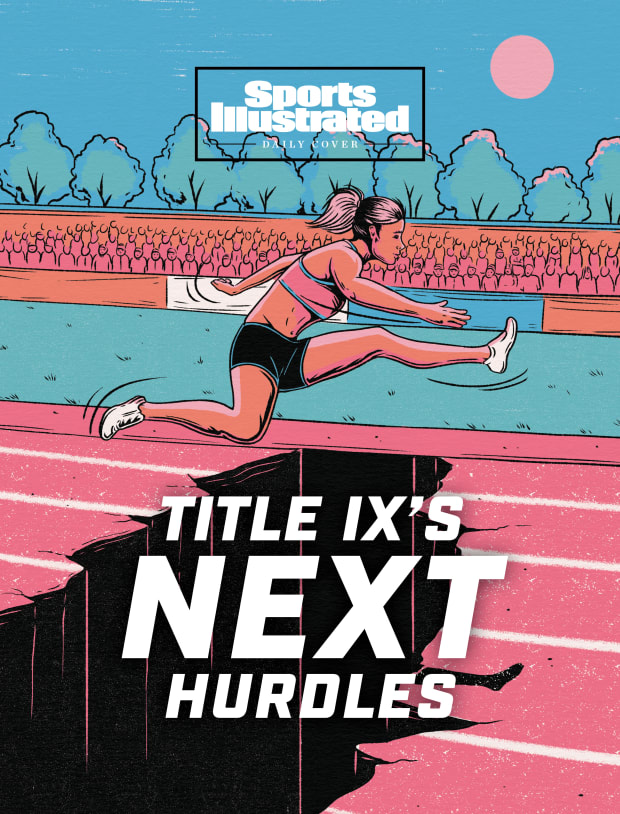
Illustration by Cat Sims
The progress that has been made in shrinking that gap is due to the athletes, who still find themselves at the table fighting for their fair share from the major sporting bodies. In 2020, the WNBPA agreed to a CBA that secured higher salaries, made favorable changes to free agency and strengthened sponsorship opportunities. In February of this year, just weeks after the NWSL Players’ Association reached its first CBA with the league and increased minimum salaries, the USWNT won a six-year court battle, completing a $24 million settlement with the U.S. Soccer Federation that (finally) guaranteed equal pay with the men’s team.
But the leagues and the corporate world are starting to see the value of investing in the players. In May, the NWSL achieved a new level of equal pay when it partnered with UKG for a multimillion-dollar, three-year sponsorship of the NWSL Challenge Cup. The deal increased the player bonus pool tenfold for the 2022 preseason tournament and will double starting in 2023, matching it with the equivalent men’s tournament.
“We have a lot of growth in front of us [as a league], but it's our opportunity right now, given the state of the world and the fact that these athletes are true cultural icons, to really unlock the potential by partnering with the athletes,” first-year NWSL commissioner Jessica Berman says of the deal.
It doesn’t stop at the professional level, either. Since going into effect in the summer of 2021, the NCAA’s name, image and likeness rule has been a massive success for women. Although about two-thirds of NIL deals have gone to men, through March, 60% of the non-football deals have gone to women, according to a study by NIL company Opendorse. Women’s basketball is second behind football, with women’s volleyball, women’s swimming and diving, and softball in the top six.
“I think corporations are more broadly understanding that diversity, equity, inclusion and belonging are business imperatives and it's very important when you have 50% of the world identifies as female,” says Brian K. Reaves, the chief belonging, diversity and equity officer at UKG. “It was a moment before; it's a movement now.”
There is still room for growth, however. The WNBA’s prioritization clause—which says players must prioritize the W over international winter leagues where they typically earn substantially more—goes into effect before the 2023 season and could be an inflection point for the league as players are forced to make a choice. And women’s hockey players are still split between the Premier Hockey Federation (formerly the NWHL) and the Professional Women’s Hockey Players’ Association, neither of which will gain the NHL’s official support until they are unified.
But Meghan Duggan—a former U.S. women’s hockey player and current director of player development for the New Jersey Devils—says that while a relationship between women’s and men’s pro hockey makes sense (much like the model between the NBA and the WNBA), those behind the scenes aren’t going to wait for the NHL to make an investment in order to move forward with a women’s league. “I think a working relationship is great, but I think there's a lot of great people on the women's pro side that are working to be able to survive and drive forward with or without the [NHL’s] support there,” she says.
Duggan, who is also the current president of the Women’s Sports Foundation, says that Title IX is what laid the groundwork for professional women’s sports to thrive. But to really combat the inequities that still exist, it has to be looked at from all levels of the game. “Bottom line is men are compensated at a much higher rate than women are for doing the exact same job,” she says. “And when you boil it down to the youth level, young boys are given over a million more opportunities to play sports than girls.”
As the gap slowly starts to look less like a steep cliff, there is significant reason for optimism. Athletes have more power than ever before. And for women, it’s going a long way. —Kristen Nelson
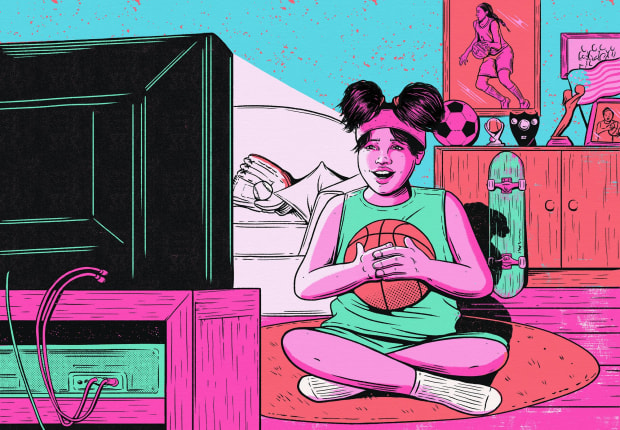
Illustrations by Cat Sims
MEDIA COVERAGE
Participation in sports by young girls is often cited as an example of steady progress since Title IX was implemented, but there’s one area, a half century later, that still remains stuck in the 1980s. Women’s sports representation in the media is virtually unchanged, according to a study of coverage from ’89 to 2019, published in March ’21 in the peer-reviewed bimonthly journal, Communication & Sport. On TV news and highlight shows, including ESPN’s SportsCenter, women athletes totaled only 5.4% of all airtime, a negligible difference from 5% in 1989 and 5.1% in ’93. Take away the 2019 Women’s World Cup and that number drops to 3.5%.
The report, titled “One and Done: The Long Eclipse of Women’s Televised Sports,” details gender asymmetries across networks and digital media. It found that men’s sports (particularly the “Big Three” of basketball, football and baseball) received the majority of coverage, while women’s sports typically got the “one and done” treatment, or a single story sandwiched between more extensive men’s news items.
Despite the dismal findings, a ratings snapshot of just one major sports weekend in April of this year revealed what can happen when women are given premium airtime: The South Carolina–UConn national championship basketball game was the most-watched women’s NCAA tournament final in almost 20 years, with 4.85 million viewers tuning in, an 18% jump from 2021 and 30% from ’19. A day earlier, the NWSL Challenge Cup match between the San Diego Wave and Angel City FC drew 456,000 viewers, a mark that MLS has surpassed only twice through mid-April and that paces with the weekend’s top soccer games of Leicester City–Manchester United (608,000), Newcastle-Tottenham (573,000) and Brentford-Chelsea (463,000).
That type of historic success is what the Women’s Sports Network hopes to capitalize on, offering a simple solution to decades of vying for prime TV slots. Launching in June 2022—purposefully timed with Title IX’s 50th anniversary—the 24-hour, ad-supported streaming channel from Los Angeles–based Fast Studios will air events from partners such as the LPGA, U.S. Ski and Snowboard, and World Surf League, as well as news and talk programming, including Game On, a daily studio show featuring scores and highlights.
“If you build it, they will come,” says Carol Stiff, a 30-year ESPN veteran and Women’s Basketball Hall of Fame inductee who is on the network’s advisory board, along with Allyson Felix, analyst LaChina Robinson
and USTA executive Stacey Allaster, among others. “We’re putting [women’s sports] where people can find it and not have to search for it,” Stiff says. “That’s what this network is going to be all about.”
While recent numbers show the potential for a hungry audience, Stiff says the channel’s benchmark for success will ultimately be its ability to attract advertisers, which will influence the investment in women’s sports rights, programming, marketing and more.
“Until we get Madison Avenue to double down and spend money on supporting women’s sports, I don’t know where we will be 50 years from now. Hopefully not in the same place,” she says. “That’s going to be the driver here; that’s what we’ve been missing. And that’s what we need.” —Jamie Lisanti
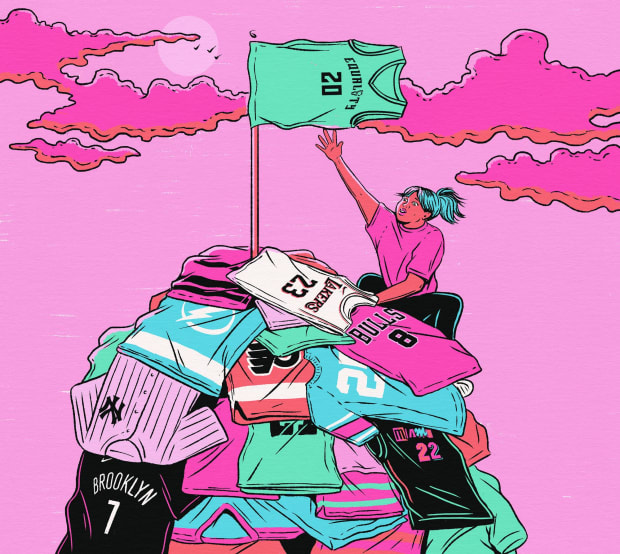
Illustrations by Cat Sims
SPORTS MERCHANDISE
When Sky shooting guard Kahleah Copper dropped 22 points in Game 3 of the 2021 WNBA Finals last October, Tyrone Palmer was in the stands, thinking the same thing he had so often that season: Man, I wish I could buy her jersey.
Palmer, a native Chicagoan and a social worker at a local high school, had embraced his hometown Sky as they grinded toward their first championship last season. He’d zeroed in on Copper as a favorite player—which, naturally, led him to seek out a jersey. But he was surprised to find that it was an impossible quest. The 27-year-old Copper was a starter in her fifth season with the Sky and her sixth in the WNBA; it seemed obvious to him that some gear should be available with her name on it. Yet as the playoffs got underway, there were no Copper jerseys for sale through the Sky, the WNBA or official league merchandise partner Dick’s Sporting Goods. And not just in Palmer’s size—none, period. Adults and children, all sizes and all colors.
“I kind of just naturally assumed I would be able to find that,” Palmer says. “At least, watching a lot of men’s sports, if you want the jersey of a player—it exists.”
And it wasn’t just Copper. If a Sky fan watching the playoff run wanted to rep hometown legend Candace Parker? Too bad. Her jersey hadn’t been restocked in months, either. It highlighted an issue the WNBA had been struggling with for years. Merchandise can be a crucial part of telling the story of a league—not just as a revenue stream but as a marketing strategy, too, allowing people to broadcast their fandom to everyone they see. It builds a sense of community and boosts visibility.
There have been a few notable success stories here for the WNBA. (Hello, orange logo hoodies.) But there have been far more fans left frustrated, in search of supply to meet their demand. A snapshot of the W’s official online store in mid-April showed 38 “ready to ship” jerseys available; the same section on the NBA’s site offered 1,290 different options. Copper’s jersey was the ultimate example. Even when the 2021 Finals MVP signed a multiyear extension with the Sky, there were no jerseys available.
“It was a small thing, but it was just frustrating,” Palmer says. “I was like, I want to give you my money; I will pay whatever markup there is. But it just didn’t exist.”
The last two years have yielded some particular supply-chain issues, and the WNBA is still expanding its partnership with Dick’s. But the league acknowledges that there is room for it to improve here.
“We have to do better at letting our fans know when they can get it, where they can get it,” WNBA commissioner Cathy Engelbert said about merch at a news conference in February. “We look forward to seeing a difference on that in the next year or two.”
A few days after Engelbert’s press conference, Kahleah Copper jerseys were finally, finally back in stock on the league’s website. “It felt like a long journey,” says Palmer with a laugh, describing what it was like to fork over his money at last. When the jersey eventually showed up at his door, he shared it on Twitter, collaging a picture of him smiling with the new gear alongside his frustrated pleas for it from the last few months. Copper herself saw the post and weighed in:
“The wait is ovaaaaaaa! Finally!” —Emma Baccellieri
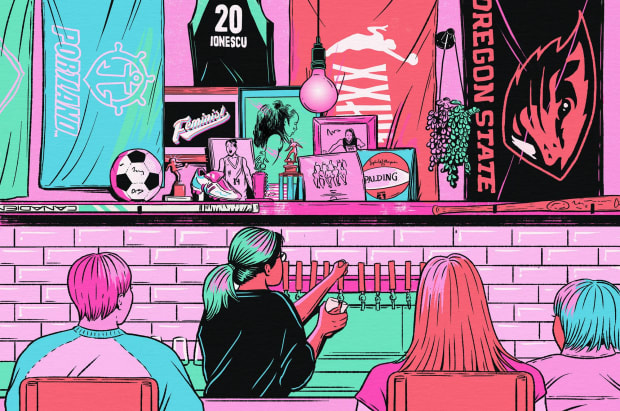
Illustrations by Cat Sims
MAINSTREAM ACCEPTANCE
A few years ago, Portland chef Jenny Nguyen and her friends went to a sports bar for the NCAA women’s basketball championship. The game was a blast. Yet their viewing experience left something to be desired—by request, a bartender changed the channel on one television to the women’s title game, but Nguyen and her crew were relegated to the corner of the bar. And of course there was no sound. Nguyen and her friends were used to that. (Many women’s sports fans are.) But she allowed herself to dream a little: What if it didn’t always have to be like this?
Imagine if there was a bar—just one, somewhere, anywhere—with women’s games as the default rather than the special request. Nguyen went home and tried to look it up. She couldn’t find anything. So she decided to build it herself.
“It was kind of bittersweet,” she remembers. “Like, sweet, here’s a niche market that I feel can be really successful. And at the same time . . . there’s been all this progress, but there wasn’t a place like this already, which was mind-boggling.”
Her creation, The Sports Bra, opened its doors in Portland in April. At a glance, it looks like any other sports bar, with memorabilia all over the walls and televisions showing games at all hours of the day and night. But it’s the first of its kind in the U.S.: Here’s a place where women’s sports are not made to feel like an exception. Instead, they’re simply the rule.
The logistics can be a bit tricky. Given how little mainstream sports programming is devoted to women, getting a women’s event on every television, every night, has meant collecting a hodgepodge of licenses and even directly reaching out to smaller leagues for permission to stream their games in a commercial setting. But that has yielded all kinds of happy surprises. Nguyen fondly recalls a weeknight of everyone in the bar getting into women’s college bowling when it was the only thing on. And it has served as a reminder: There are lots of women’s sports, and if someone’s only willing to turn them on at a bar, people will sit down and watch.
While the menu includes an array of typical sports bar grub (think burgers, wings, nachos and tater tots), the list of signature cocktails features a handful of aptly named drinks—The GOAT, Title IX, Pickle Ball and Triple Axel—all featuring Freeland Spirits, a local women-owned distillery. The house wines are curated by Sarah Cabot, a winemaker who doubles as a running back for the Oregon Ravens, a women’s pro football team.
Nguyen has been heartened by the early response. She rushed to hire more staff after the success of the opening weekend. It helps that she’s tapped into an existing women’s sports community in Portland: The local Thorns regularly lead the NWSL in attendance, and the city has plenty of women’s college basketball fans, particularly of the Oregon Ducks. But Nguyen thinks this idea could work in many different cities, and she hopes that soon, it might not seem so revolutionary.
“I would be thrilled if other women’s sports bars popped up,” she says. “Or if every sports bar decided to dedicate one TV, just one TV in their whole bar, to women’s sports, day in and day out—that, to me, would be a win. I feel like that’s not asking a lot.”
Nguyen scheduled the grand opening of The Sports Bra for the weekend of the women’s Final Four. It felt like a full-circle moment from when she had been inspired to create the bar in the first place. Now, women’s games were on every television the place was crammed with people and the volume was up. Yet she still couldn’t hear the broadcast.
“It was so loud,” Nguyen recalls, a grin spreading across her face. “It was like electricity.” —E.B.
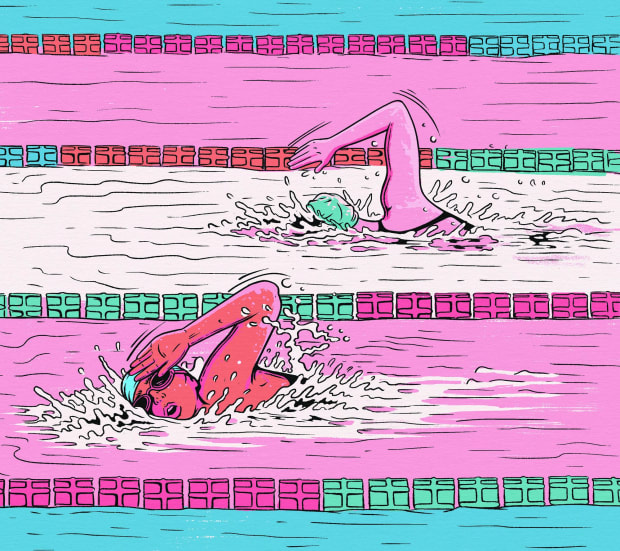
Illustrations by Cat Sims
TRANSGENDER ATHLETES
One big question looms over Title IX as the legislation enters its second half century: How does the statute apply to transgender athletes?
The group was not on most women’s sports advocates’ or the general public’s radars in 1972. Sports were not even a main focus of Title IX when it was passed. But today, politicians and activists routinely invoke the law as the reason for banning trans athletes (often girls and women, in particular) from playing sports. The latest high-profile debate was sparked by the success of trans college swimmer Lia Thomas for Penn this season.
At least 15 states currently ban trans athletes, ranging from middle school to college, from publicly funded sports that align with their gender identities. Lawmakers in those (largely conservative) states argue that trans women take scholarship opportunities away from cisgender women, and that they make for an unlevel playing field. These legislators say they are “protecting Title IX.”
Those advocating for trans inclusion in sports also claim the mantle of Title IX, arguing that banning trans athletes from competing in their gender category is textbook discrimination on the basis of sex.
Upon taking office, President Joe Biden instructed his government that Title IX does prohibit gender-based discrimination against trans people. While that means trans people cannot be discriminated against in most educational settings, Western New England University Law School professor Erin Buzuvis, who specializes in Title IX issues, says it remains to be seen how Biden’s direction will be applied to situations like sports, which we’ve accepted can be segregated by gender. That differs from, say, college admissions or French club, where there’s no separation by gender. Meanwhile, in three of the states with trans sports bans—Idaho, Tennessee and West Virginia—trans athletes have joined with groups including the ACLU and Lambda Legal to sue for their right to compete.
Though Title IX isn’t the law in question in the court cases, once they work their way through the system we may gain clarity on what and whom the statute protects.
That could take years, though, and, in the meantime, the fight over how Title IX applies to trans athletes will take place among activists, in the media and on the political battlefield.
The stakes in this fight for trans people, already a vulnerable population, are high. The debate itself has already proved harmful. A 2020 peer-reviewed study found that trans and nonbinary youth who have experienced discrimination based on their gender identity are twice as likely to attempt suicide as their peers. And more than half of trans and nonbinary youth considered suicide over the course of the previous year, according to a ’21 Trevor Project survey. In the same survey, 94% of LGBTQ youth reported that recent politics have negatively affected their mental health.
Along with the revival of the so-called bathroom bills and restrictions on trans-affirming health care for youth, the anti-trans sports laws are “about banning trans people and limiting our access to our everyday activities,” duathlete and trans rights activist Chris Mosier told SI. “It’s about erasing trans people from public view.”
They are also about who holds the right to be a woman under Title IX. —Julie Kliegman







